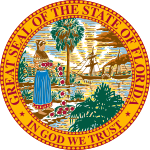| ||||||||||||||||||||||||||
| ||||||||||||||||||||||||||
 County Results
Cleveland 50–60% 60–70% 70–80% 80–90% 90–100%
| ||||||||||||||||||||||||||
| ||||||||||||||||||||||||||
| Elections in Florida |
|---|
 |
|
|
The 1892 United States presidential election in Florida took place on November 8, 1892. All contemporary 44 states were part of the 1892 United States presidential election. Florida voters chose four electors to the Electoral College, which selected the president and vice president.
This election marks the end of Reconstruction and the beginning of Jim Crow-era politics in Florida. This change had been proposed as early as 1884, but the anti-Southern animus of the Harrison regime meant that Florida's large landowners felt the disfranchisement of blacks had become urgent.[1] A poll tax was introduced in 1889[2] as were the so-called “Myers” and “Dortch” laws which required voters in more populous settlements to register their voting precincts.[3] This dramatically cut voter registration amongst blacks and poorer whites, almost halving the number of votes cast. Since Florida completely lacked upland or German refugee whites opposed to secession, its Republican Party between 1872 and 1888 was entirely dependent upon black votes. Thus this disfranchisement of blacks and poor whites by a poll tax introduced in 1889[4] left Florida as devoid of Republican adherents as Louisiana, Mississippi or South Carolina.[5]
Thus, Florida's few remaining Republicans decided not to put up presidential electors and urged their supported to back Populist James B. Weaver,[6] creating the first case where an incumbent president standing for re-election has not been on all state's ballots.[a] Weaver thought he had “magnificent” chances in the impoverished South,[7] and campaigned heavily there.[7] but as it turned out the halving of the electorate meant he could gain very little support. Weaver was not helped by his controversial decision to take a woman – Mary Lease – on his campaigns, as the South thought any political involvement degraded womanhood.[8] Weaver did nonetheless win counties in Alabama, Georgia, Mississippi, North Carolina, and Texas.
Florida was won in a landslide by the Democratic nominees, former President Grover Cleveland of New York and his running mate Adlai Stevenson I of Illinois in what remains as the best performance in Florida as of 2020. Weaver took what remained of the Black Republican vote, but gained less than 14%; nonetheless this is one of only five times in Florida that a candidate other than a Republican, Democrat, or Whig (the Democrat's main opposition before the formation of the Republican Party) got over 10% of the vote.[b]
- ^ Perman, Michael; Struggle for Mastery: Disfranchisement in the South, 1888-1908, pp. 67-68
- ^ Brooker, Russell; The American Civil Rights Movement 1865-1950: Black Agency and People of Good Will, p. 61 ISBN 0739179926
- ^ Ogden, Frederick D. (1958); The Poll Tax in the South, p. 118
- ^ Silbey, Joel H. and Bogue, Allan G.; The History of American Electoral Behavior, p. 210 ISBN 140087114X
- ^ Phillips, Kevin P.; The Emerging Republican Majority, pp. 208, 210 ISBN 9780691163246
- ^ Knowles, George Harmon (1942); The Presidential Campaign and Election of 1892, p. 242
- ^ a b Richardson, Darcy G.; Others: Third Parties During the Populist Period, p. 138 ISBN 0595443044
- ^ Kauffman, Gina; More Than Petticoats: Remarkable Kansas Women, p. 36 ISBN 0762776331
Cite error: There are <ref group=lower-alpha> tags or {{efn}} templates on this page, but the references will not show without a {{reflist|group=lower-alpha}} template or {{notelist}} template (see the help page).
© MMXXIII Rich X Search. We shall prevail. All rights reserved. Rich X Search


